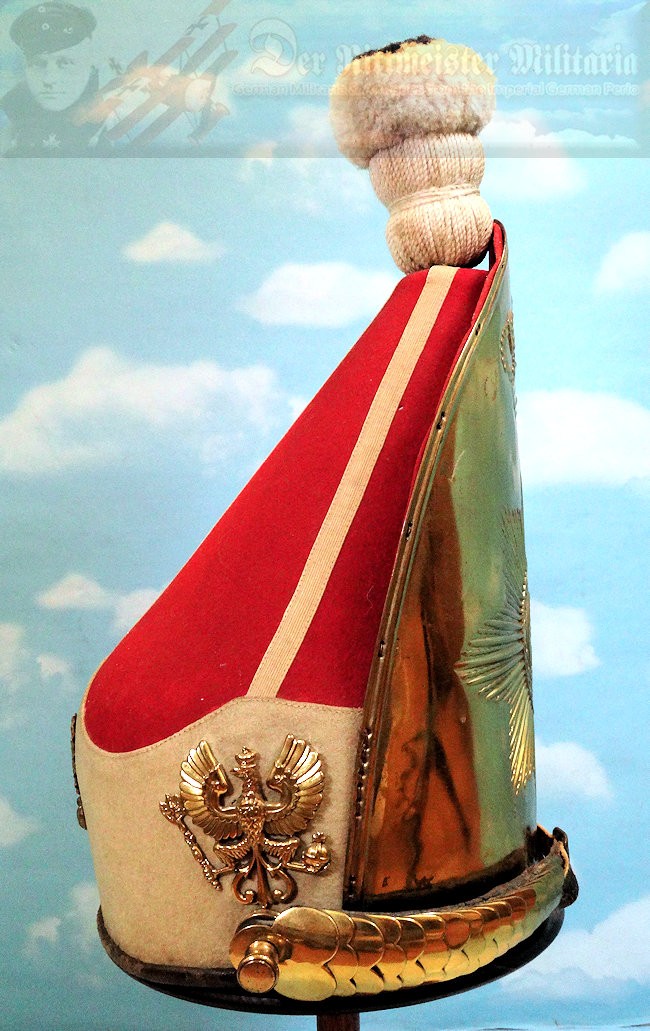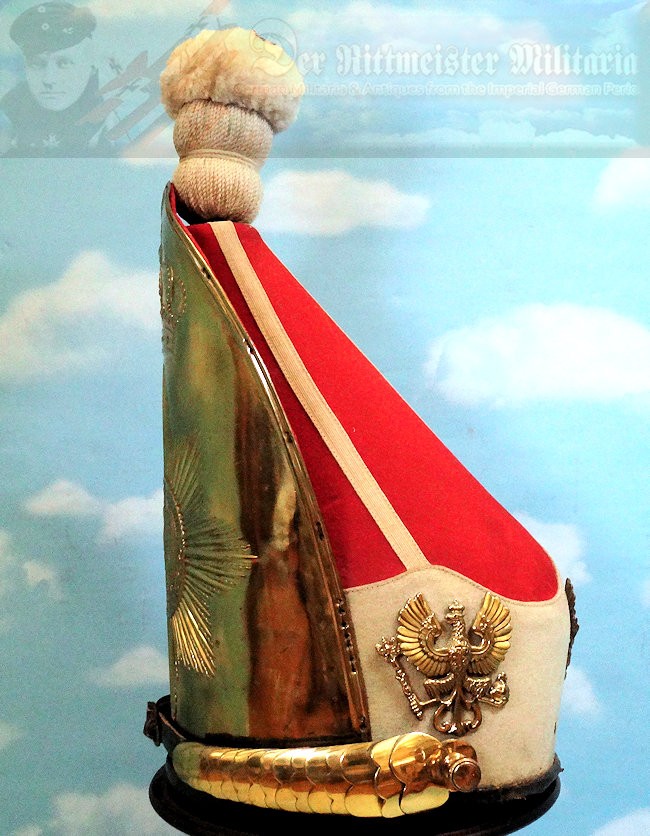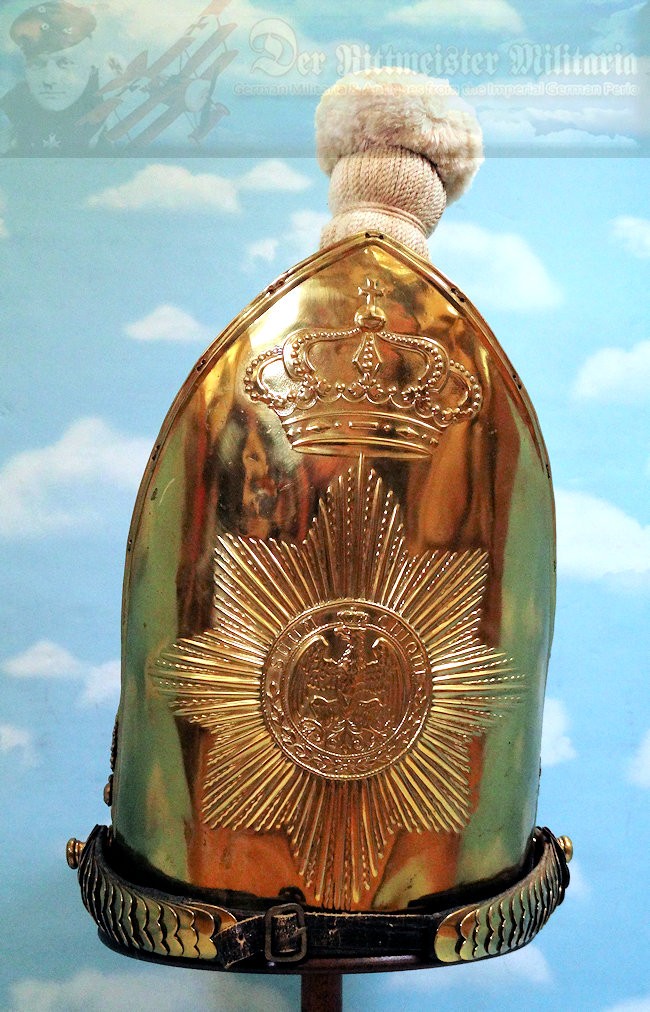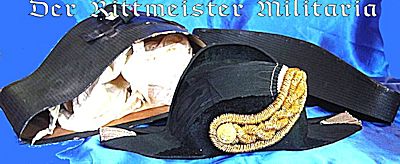Description
MITRE – RUSSIAN-STYLE – ENLISTED MAN – KAISER ALEXANDER GUARD GRENADIER REGIMENT 1 BATAILLON NR III (FÜSILIER)
This is a beautiful and very rare Mitre from Kaiser Alexander Guard Grenadier Regiment 1 Bataillon Nr III (Füsilier). The 1.Guard Grenadier Regiment, also known as the Kaiser Alexander Guard Grenadier Regiment 1 (KAGGR1), was founded in 1814 and garrisoned in Berlin. [It must have been one of Kaiser Wilhelm II’s favorite regiments for it to be awarded the Erste Garde Regiment zu Fuß’s (EGRzuFUß) old Mitres when they received their new ones in 1894]! Its front shield is made of brass-plated sheet metal, and bears a relief Order of the Black Eagle underneath a large crown. The metal shield is backed with red cloth for Bataillon Nr III.
The Mitre’s body is formed by an aluminum cone, then covered with red wool that sports three white strips running from its top down to the headband. The white cloth border/headband around the Mitre’s base boasts three brass heraldic eagles, one on either side, with the third attached at its rear. The correct, arched, brass, chin scales are attached to the Mitre by knurled knobs. [PLEASE NOTE: the Infanterie’s scaled metal pickelhauben chin straps were flat, NOT arched. Also note that the style, shape, and height of this Mitre are different from that of the EGRzuFUß’s Mitre].
Its condition is excellent, with no moth holes or nips. Remember, this very rare Mitre was worn by only one Bataillon of one Regiment, or 0.1% of the Imperial German Army. This is a consignment item.
The Grenadiermütze (Grenadier Cap) or Mitre style of headdress dates back to the 1600s and Frederick the Great. It was worn by numerous German Infanterie units throughout the 17th, 18th, 19th, and part of the 20th Centuries. The Mitre’s body was a tall cloth bag with white strips around its base and a large metal front plate. Leather pickelhauben replaced Mitres during the mid-1800s. By 1894, only three out of the hundreds of German Imperial Army Infanterie units still wore the Grenadier Mitre, and then it was only for parades or palace duty. These units were: the Erste Garde Regiment zu Fuß (EGRzuFUß), the Kaiser Alexander Garde Grenadier Regiment NR. 1 (KAGGR1), and the Schloß Garde Kompagnie (Palace Guard Company). It was quite an honor to have these distinctive headdresses.
The Erste Garde Regiment zu Fuß (EGRzuFUß) was established on 11 August 1688 and garrisoned in Potsdam, just outside of Berlin. In 1824, its Bataillon II’s enlisted men were authorized by Allerhöchste Kabinettsorder (Supreme Cabinet Order – A.K.O.) dated 30 March 1824 to wear the very distinctive and colorful headdress known as the Grenadiermütze or Mitre for parades and special occasions. On 10 August 1824, Bataillon I’s enlisted men also were authorized to wear the Grenadiermütze. Only the enlisted members of these Bataillone wore this item for parade, while the remainder of the regiment still wore their normal day-to-day headgear with a white plume or bush for parade. The Mitre initially was reserved for enlisted men, but at parade on 26 March 1826 Bataillone I & II’s unmounted officers finally were authorized to wear the Grenadiermütze style.
In May 1843, Bataillon III (Füsilier) finally was authorized to wear a Grenadiermütze for parade. While their Grenadiermützen were similar to the ones worn by Bataillone I & II, their Grenadiermützen bodies were shorter, possessed a slightly different shape, and the grenades around their headbands were replaced by heraldic eagles.
In January of 1889 the 3rd and 4th Companies were honored by the addition of the “SEMPER TALIS” (Ever-Following/Always Faithful/Always the Same) bandeaux to their Mitres and leather spiked helmets. (A.K.O. dated 27 January 1889). In either the summer of that year or May of 1890 the rest of Bataillon I and the Regimental staff were also authorized to wear them. The enlisted men’s bandeaux were made from brass, while those for the officers were made of German silver and their letters were sometimes colored in with red lacquer.
On 9 February 1894 the EGRzuFUß troops of the 1st (Leib), 5th, and 9th Kompagnien were gifted by the Kaiser with new Grenadiermützen for parades. [At that time, these mounted companies’ officers, staff and adjutants still wore pickelhauben with white plumes (or black for the Füsiliers)]. By December 1894, all EGRzuFUß Kompagnien had received the new style of Mitre.
The EGRzuFUß’s new Grenadiermütze was patterned after one worn by Frederick der Große’s Regimental Guard (Königlich Preußisches Regiments Garde Nr. 15, from 1753 to 1786). It was made from pressed or stamped, white, sheet metal and did not have a scaled metal chin strap. Bataillone I & II’s Mitres sported red cloth trim around their front plates, red cloth bodies with three white cloth strips running from peak to base (silver bullion for the officers), and the “Semper Talis” bandeaux. [This was unusual, since only Bataillon I and the Staff were authorized to wear this banner on their helmets]. The Fusilier Bataillon had a gold cloth body with white strips and the “Pro Gloria Et Patria” (For Glory and Country) inscription on the bandeau above the eagle.
Initially, no chin strap was worn on the new Grenadiermütze; instead, the Mitre was held in place with a leather string that tied under the chin. This method did NOT keep the Grenadiermütze in place and it frequently fell off of the soldier’s head! In 1897, flat, scaled, metal, chin straps were authorized for the Grenadiermütze. Model 1891 chin strap posts were then added to the Grenadiermütze, with the wearer using the metal chin straps from his pickelhaube on his Grenadiermütze. After parade, the chin strap was removed, and the Grenadiermütze was stored in an oil cloth cover in the regimental storeroom. [More about this oil cloth cover will appear later in this special update].
When the EGRzuFUß received their new Grenadiermützen in 1894, they turned their old ones over to the Kaiser Alexander Guard Grenadier Regt.1 (KAGGR1). It appears that they made this transition between corresponding companies. The SEMPER TALIS bandeaux were removed, and the KAGGR1 wore their Grenadiermützen with two holes in their front plates until they were replaced due normal wear and tear.
[For more information on these two Mitres and loads of photos, see The Grenadier Mütze of the Imperial German Army by Jim Turinetti].














